The Moritz Grossmann Hamatic, and its “Modernly Old-School” Self-Winding Hammer System
Moritz Grossmann's first automatic watch does not come with your typical self-winding movement!
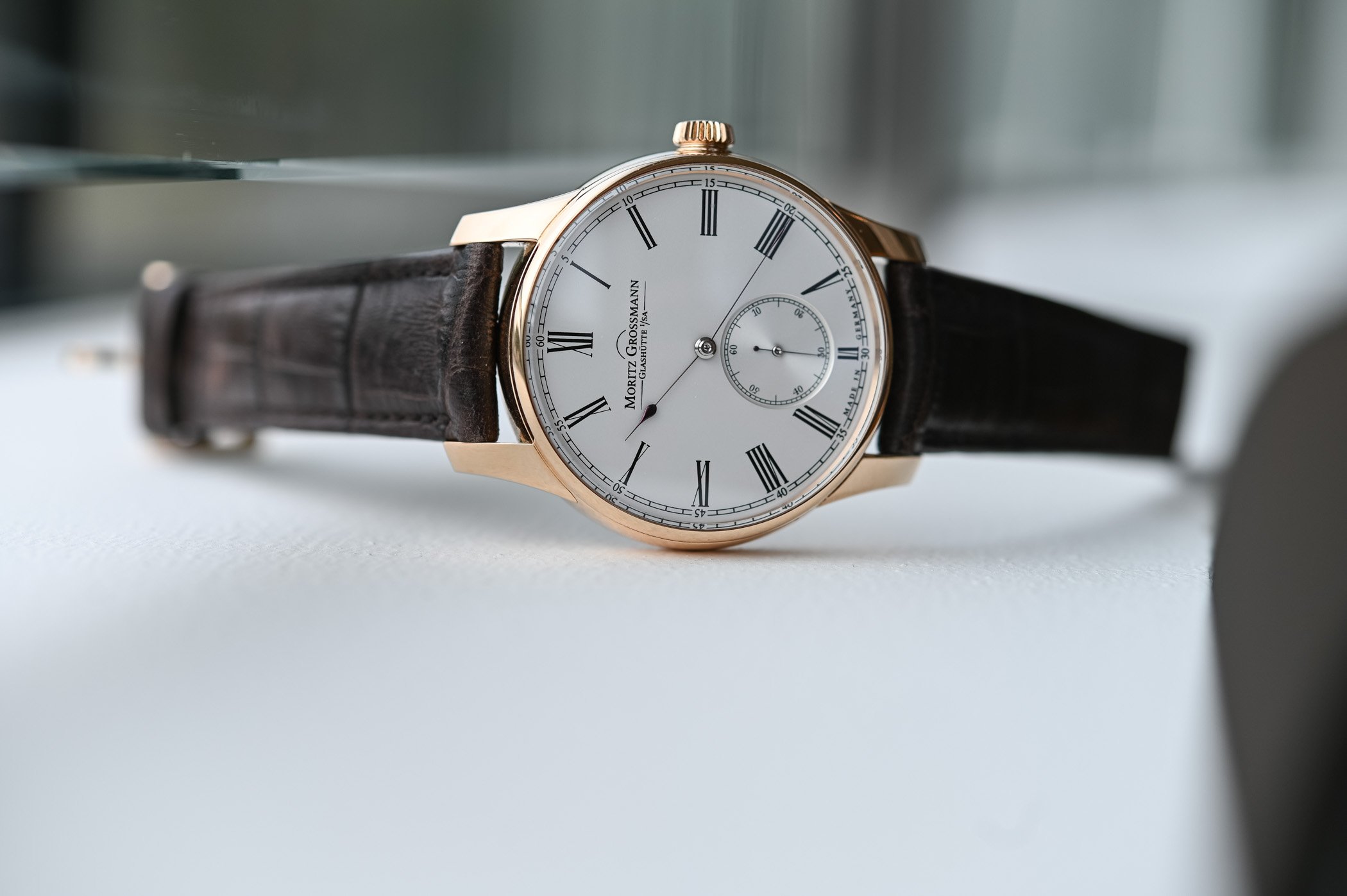
Last year, German manufacturer Moritz Grossmann, one of Glashütte’s best representatives, presented its very personal vision of an automatic watch, the Hamatic. Impressive, mechanically fascinating but still a prototype, the watch needed a few more months to be perfected. But here is the final version of the Moritz Grossmann Hamatic, now without cut-outs on the dial but still with the same desirable movement and its unique self-winding hammer system.
An ode to early perpétuelle watches
The whole point of the Moritz Grossmann Hamatic clearly isn’t visible on its habillage – it does, indeed, look like a classic hand-wound, time-only piece. Everything this watch stands for lies in its movement, and in particular, its intentionally anachronic self-winding system. This watch is an ode to the earliest automatic watches, timepieces created around 1780 featuring a so-called “hammer” or “bumper” winding mechanism.
For centuries, watches have been mechanical (until the advent of the quartz/battery-powered in the late-1960s), meaning that their movements relied on the energy provided by a mainspring. And like every kind of spring, if you want it to release its power, you have to wind it first. It was initially done manually, by hand-winding the movement thanks to a key or later a crown. But, some watchmakers started to think that it would be rather convenient to have a watch running perpetually, without the need to wind its mainspring.
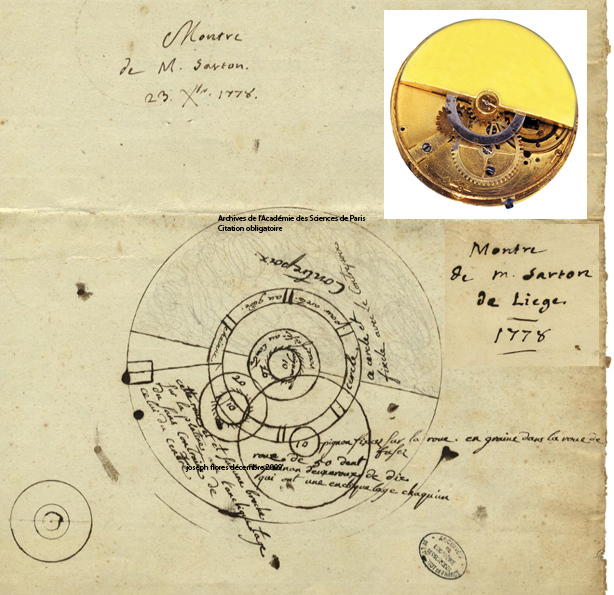
There is still some debate concerning who actually invented the first automatic movement, which is still often – but wrongly – credited to Swiss watchmaker Abraham-Louis Perrelet. According to industry journalist Gregory Pons (in French), based on research done by historian Joseph Flores, the first automatic movement should be credited to Belgian watchmaker Hubert Sarton, in 1778.
Soon after, master-watchmaker Abraham-Louis Breguet would undertake his first attempts to produce an automatic watch. After studying the concept, he created the perpétuelle movement – a French word referring to the perpetual motion of the watch. Breguet’s first watches comprising this mechanism were produced as soon as 1780, with the example of the Perpetuelle No.1 – 8/82. This watch is one of the oldest-known Breguets with this self-winding system, and also the oldest surviving Breguet watch to date. It appeared on the market in 1997, at an Antiquorum auction.
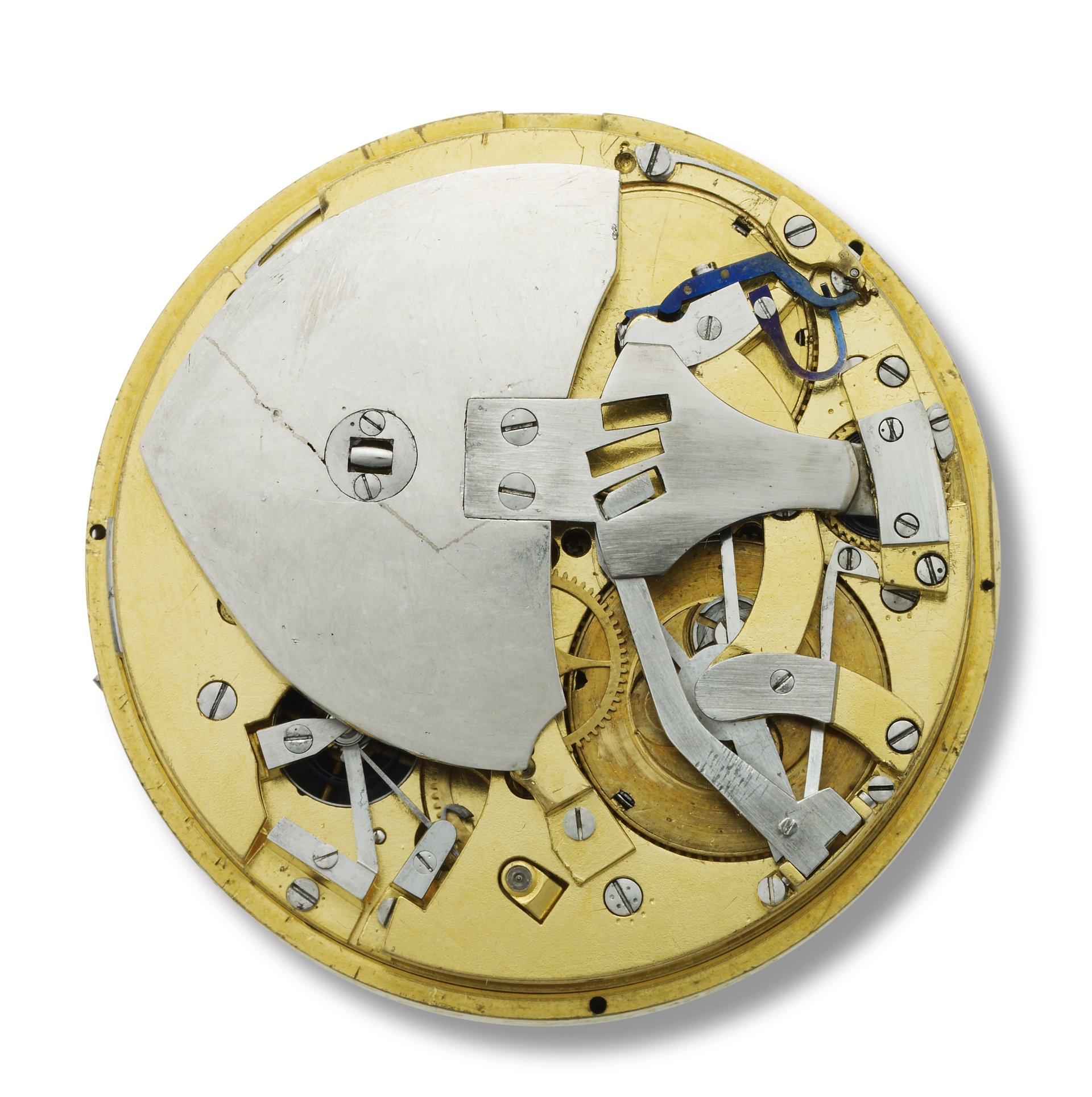
Now, let’s get a bit more technical. While today’s automatics rely on a central rotor (99% of the production), a micro-rotor or a peripheral rotor, back in 1780 the concept was a bit different. Remember that a pocket watch was worn in a pocket, meaning that it was more or less in a static position (as opposed to the constant movements of the wrist animating a wristwatch). For this reason, the best option to load the spring by using the movement of the wearer was Breguet’s system, a hammer-winding mechanism – basically, a swinging triangular mass positioned on the same axis as the wearer’s body so it could benefit from the tiniest movements, especially when walking, so the hammer was swinging from left to right, and thus loading the mainspring. However, this device resulted in shocks being transferred to the whole movement.
This is where Moritz Grossmann found the inspiration for its first automatic watch, the Hamatic, but with a massively improved hammer-winding mechanism.
The movement of the Moritz Grossmann Hamatic
Let’s start our review of the Moritz Grossmann Hamatic, back to front, by looking at its movement – because, let’s be honest, this is where this watch makes the most impression. Inside the Hamatic, and now entirely hidden on the dial side, is certainly one of the nicest automatic movements on the market, and truly, the only one of its class.
Is the Hamatic system a necessity? No! But that’s the whole point of Haute Horlogerie (and it’s just superb).
The Calibre 106.0 isn’t based on the existing calibres 100.X, the hand-wound movement found in the GMT. The winding mechanism isn’t added on top of a manual calibre but integrated into it. So what’s that…? Well, the Hamatic movement is an ode to these antique, early automatic hammer calibres produced by Breguet and other watchmakers. It is also an intentional anachronism since this type of self-winding system (at least, the old versions) is far less efficient and results in shocks damaging the movement, leaving the stage free for the unquestionably more efficient rotor. This was step one, since this movement isn’t just an ode but brings the concept into the 21st century.
The base for the automatic-hammer mechanism is the large part that covers the movement almost entirely: the swinging hammer. While a rotor rotates on 360°, this part relies on smaller oscillations, from left to right on a relatively short arc, to load the mainspring. The hammer, a large oval and open-worked element, is composed of multiple parts and comprises a dense, solid gold mass on its extremity creating the necessary imbalance.
Now, Moritz Grossmann claims that the winding efficiency of this system is almost equal to a standard rotor. How? Since the centre of gravity of the hammer is twice as far from the pivot compared to a rotor (where the distance is half the movement, but here almost the entire diameter of the calibre 106.0), this results in more leverage and torque, meaning more energy transmitted to the mainspring. In addition to that, while antique hammer devices were unidirectional, it now works in both directions of the swinging motion. Again, this adds to the efficiency.
Also, while one of the main issues with old hammer devices were shocks, the Moritz Grossmann Hamatic features two shock-absorber parts, integrated into the oval part – the two end-springs, which absorb some of the vibrations and slow down the motion of the hammer, working in conjunction with a long central blade. That was for the first part of the winding mechanism, but what about the transmission of this motion to the mainspring?
In order to convert the energy into a rotary motion, the oscillations of the hammer body are picked up by two click levers. The two-way direction of rotation of the click wheels ensures an even rotary motion, which is transferred to the free-wheel and then via reduction-wheel to the barrel’s ratchet-wheel to wind the mainspring. As one click wheel engages to wind the barrel, the other is disengaged and vice-versa. Their alternative action makes winding bidirectional. A rotation of just five degrees can be used to wind the mainspring.
Finally, the automatic winding system is complemented by a manual winder designed as a yoke winder that is mounted on a separate bridge. The yoke ensures that the manual winder is always uncoupled from the ratchet wheel when the Hamatic system is active in response to motion. In manual-winding mode, the reduction gear is isolated from the ratchet wheel by a click-pawl idler.
So, all in all, the Moritz Grossmann Hamatic not only takes an old concept and integrates it in a modern watch, but it truly redefines and improves this hammer winding device, which results in what certainly is the most desirable and “Haute-Horlogerie-inspired” self-winding system currently available – even though I still love a peripheral rotor. Just wow…
The rest of the movement isn’t to be overlooked. This large calibre features more delicacies, such as its (beautiful) in-house shock-resistant Grossmann balance with 4 inertia and 2 poising screws, combined with a balance spring with a No. 80 Breguet terminal curve. The whole escapement beats at 21,600 vibrations/hour. The power reserve is comfortable, at 72 hours.
The decoration of the movement is simply superb, with the usual 3/4 plate being replaced by a fairly open main bridge, and all the parts are decorated with circular graining, Glashütte ribbings, polished bevels, screwed gold chatons, hand-made engraving (both for the inscriptions and the cock bridge) and anglages all around. And that oval swinging hammer…!
An otherwise conservative watch
Conservative… but in a good way! While the early prototypes presented in 2018 showed cut-outs on the dial, this final version of the Moritz Grossmann Hamatic is more classical in its execution and relies on a plain dial. In fact, while worn, nothing would let you know what ticks inside, as it looks like a simple time-only watch – and, to me, this is elegance to its best definition.
The case of the Hamatic is classically shaped, with elongated, relatively strong lugs and a 41mm diameter. Two comments. First, these lugs are well designed and curved, allowing for the watch to be balanced. Second, the thickness of the watch is “only” 11.35mm, which considering the movement inside remains reasonable. The execution is flawless and the case is available in either 18k rose gold (as photographed) or 18k white gold. The watch is worn on a discreet alligator strap with prong buckle.
The dial, as clean and simple as it may seem, also requires a closer inspection. It is made of solid silver with an opaline finish. The result is a slightly grained surface with discreet metallic reflections. The small seconds sub-dial is fairly recessed into the dial adding some depth to this otherwise simple display. The elongated, thin Roman numerals and the sleek railroad track add to the classicism of the watch and echo the pocket watch inspiration found on the movement.
Last but not least, the hands. Again, discreet, elongated, thin, but extremely detailed. On the contrary to other Grossmann watches with lance hands, the hour hand stands out thanks to its pear-shaped tip, while the minute hand has a needle-like, slender (maybe too slender) design. The polished canon of the hands is also superbly executed. The hand-polished steel hands are annealed to a brown-violet hue – a rare colour. And in all objectivity, this level of execution is rarely seen in modern watchmaking.
Thoughts
Back in 2018, the prototypes of the Moritz Grossmann Hamatic already made quite an impression on us but today’s final examples are simply astonishing. First of all, the brand made the right choice in having a plain dial. Second, the movement is a feast for the eye and technically-speaking it pays tribute to antique pocket watches but also improves these early automatic mechanisms on every single level.
Personally, I love this combination of extreme discretion for the habillage (case, dial, hands) and demonstration of skills on the movement side. In addition to that, the execution is impressive and delicate. This mechanical marvel comes at a high, but in my opinion, justified price.
Price and availability
The Moritz Grossmann Hamatic has been available from authorized retailers since October 2019, in two versions – 18k rose gold (ref. MG-002302) and 18k white gold (ref. MG-002303). Both models are equally priced, at EUR 37,600 before taxes. More details at grossmann-uhren.com.

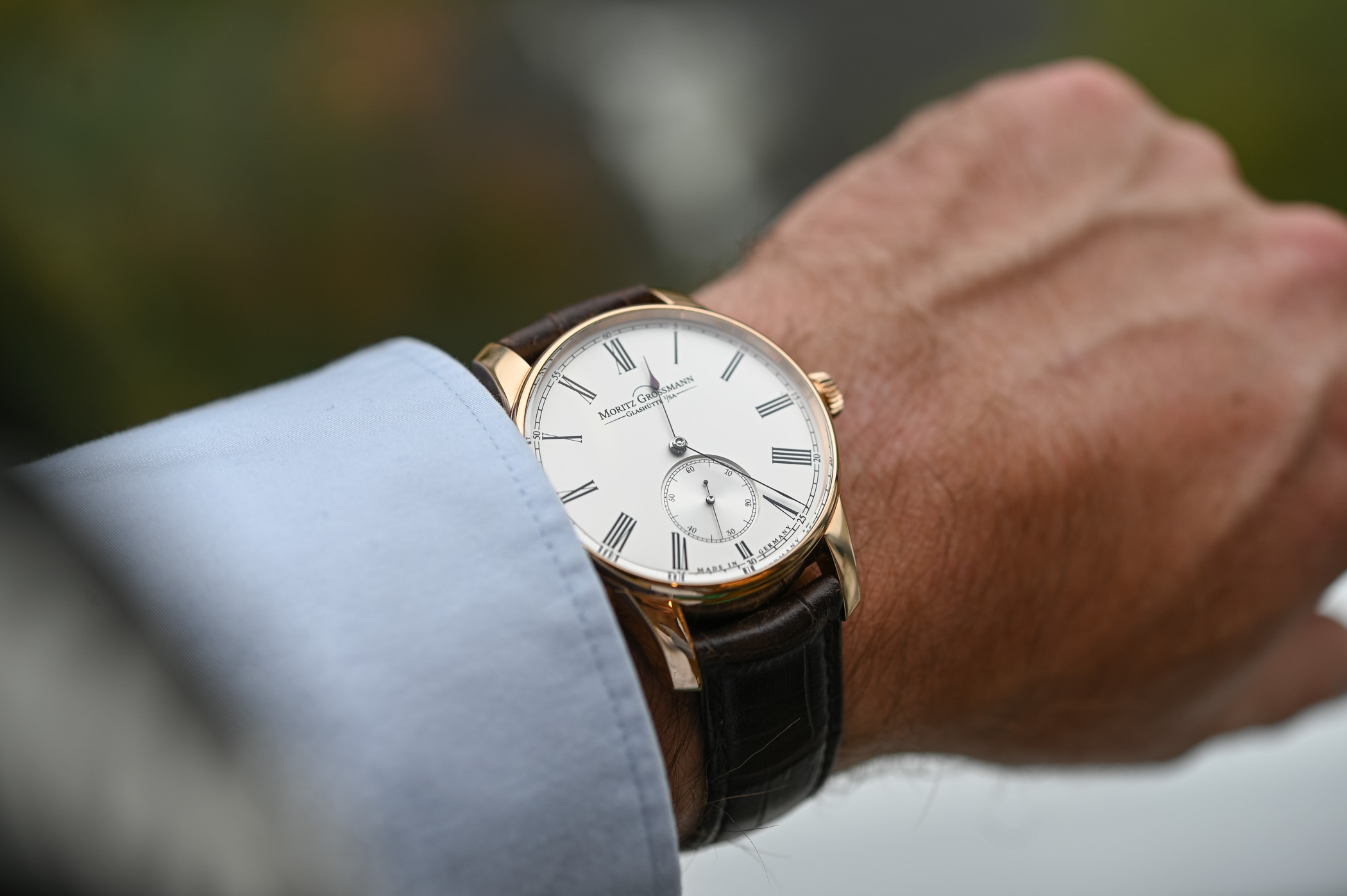

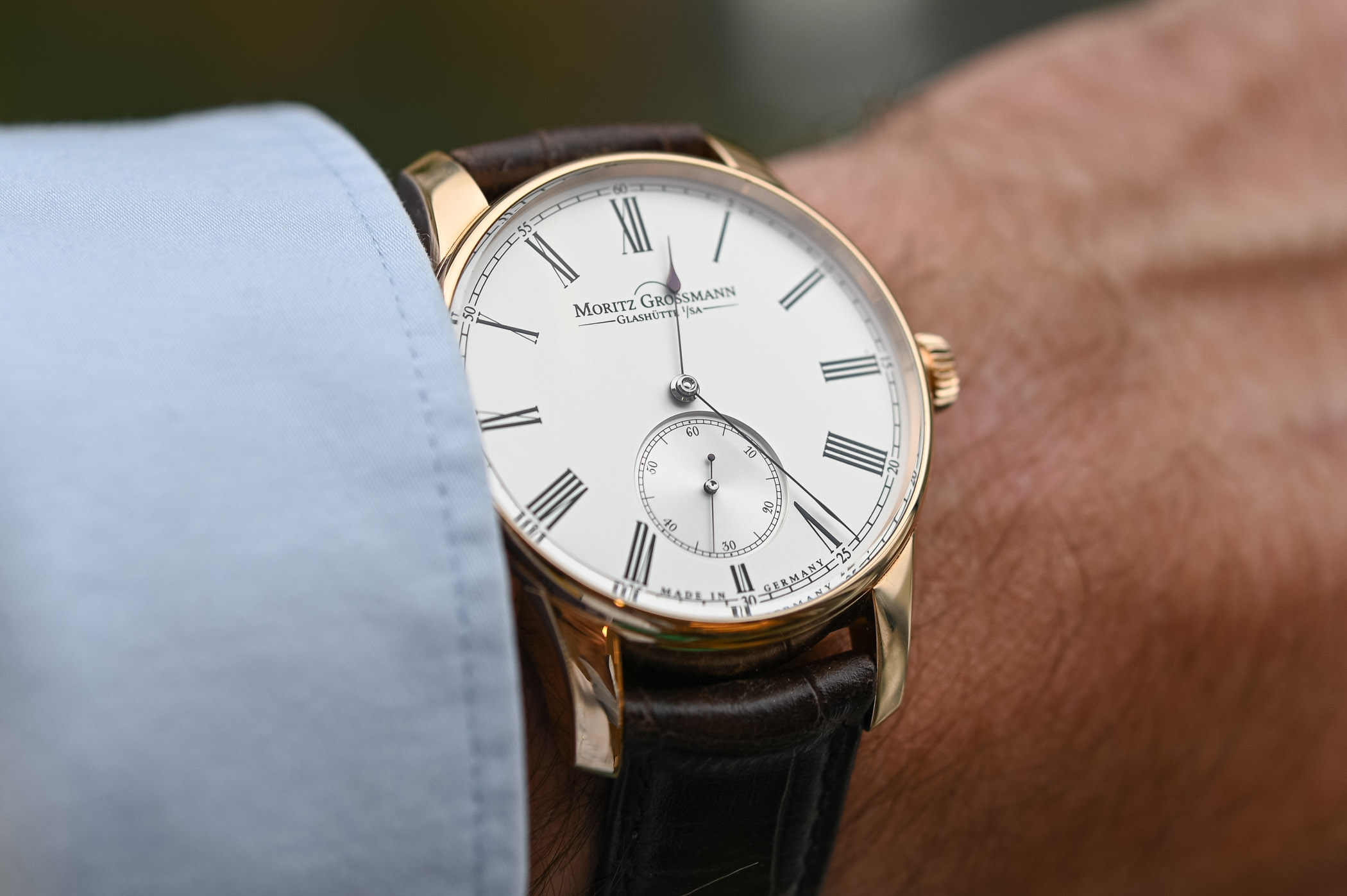


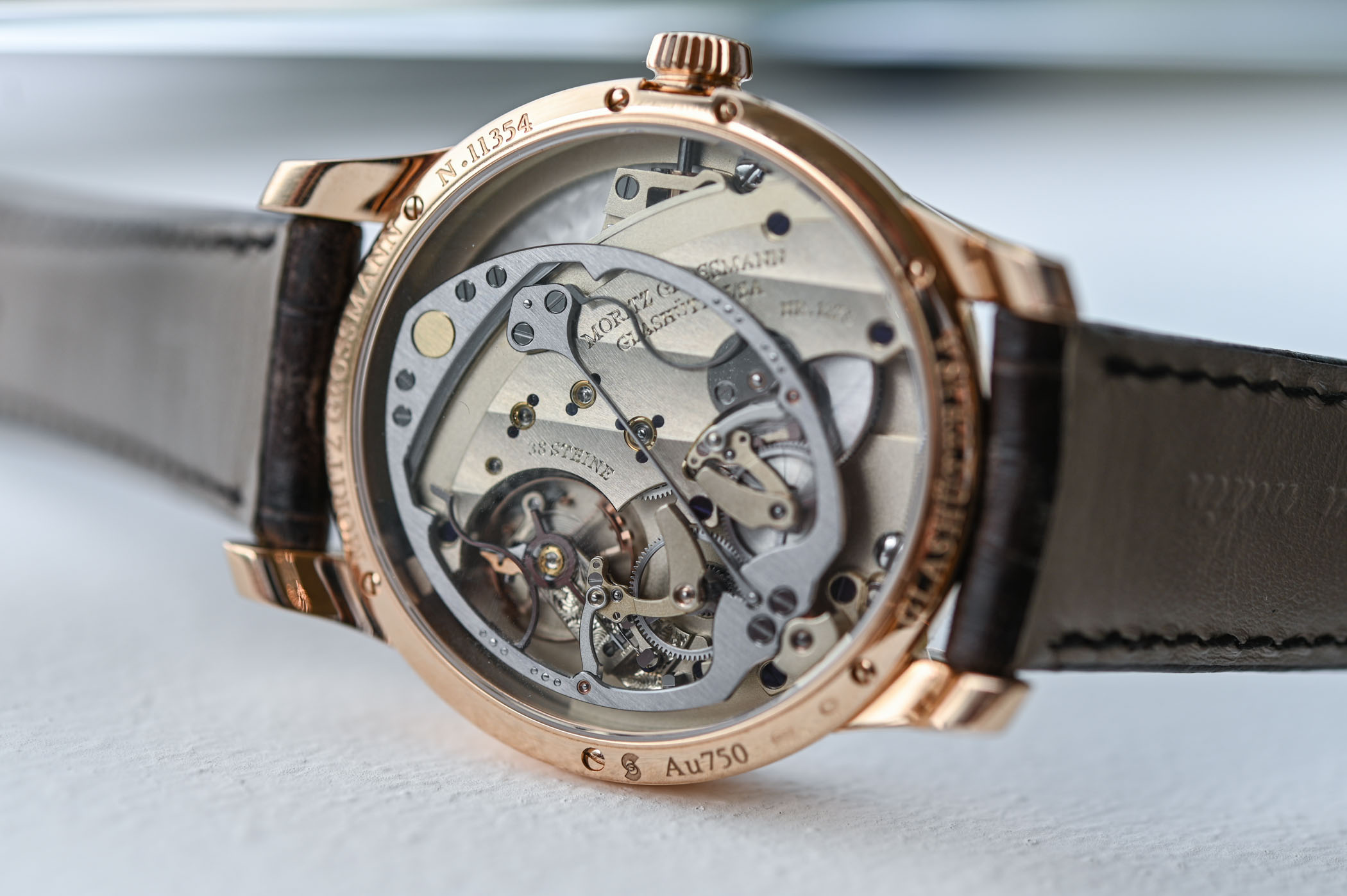
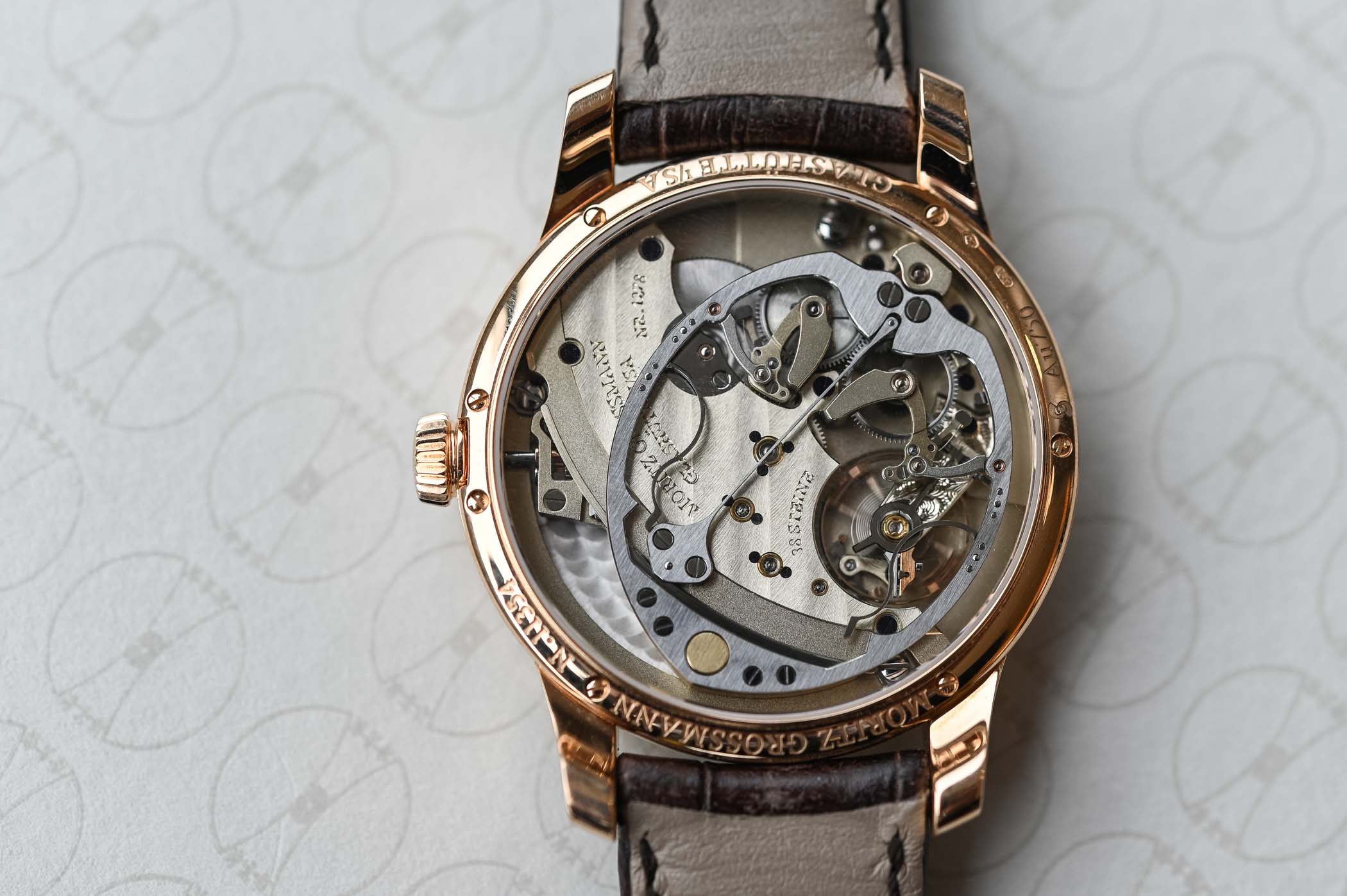
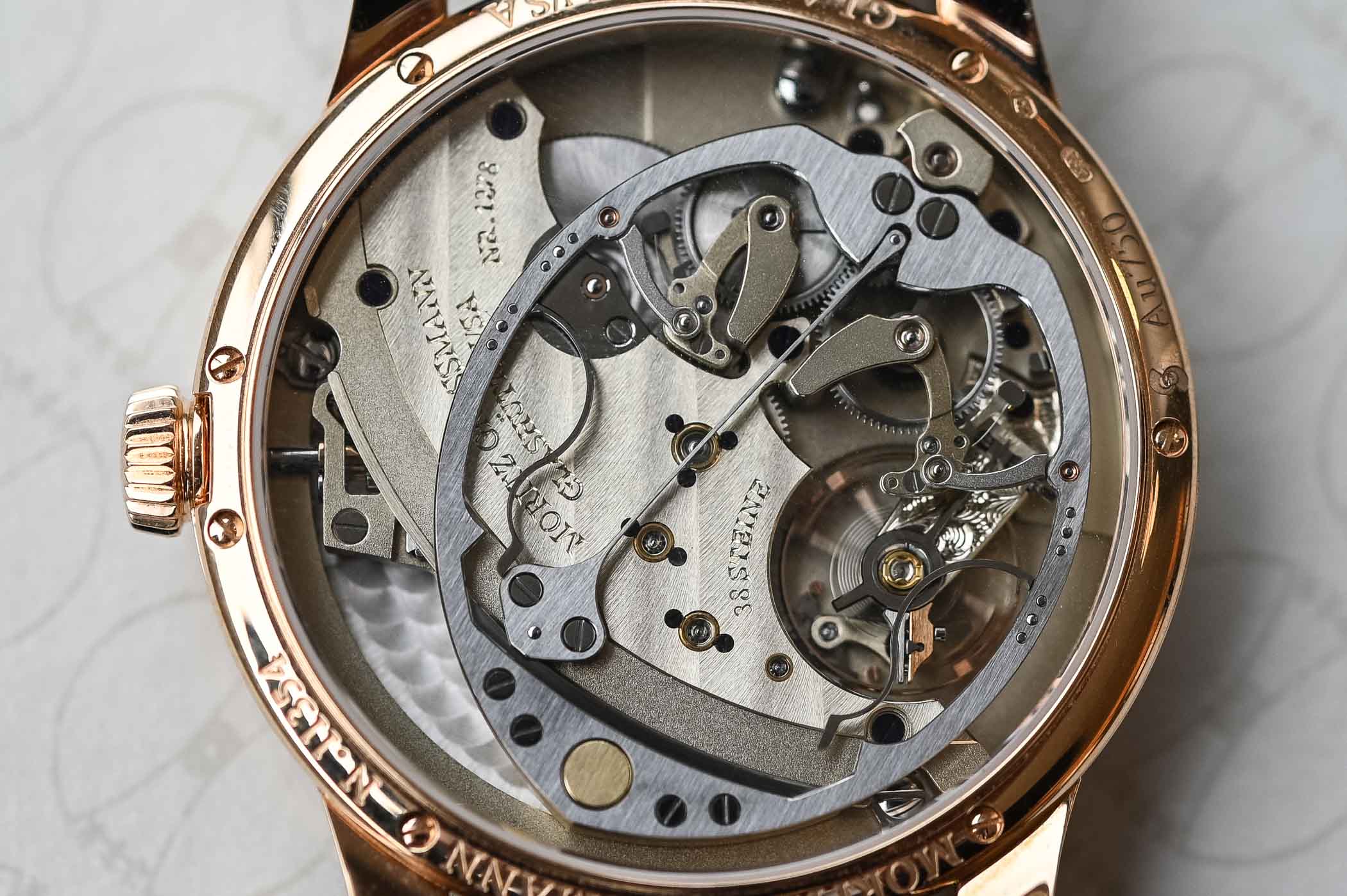
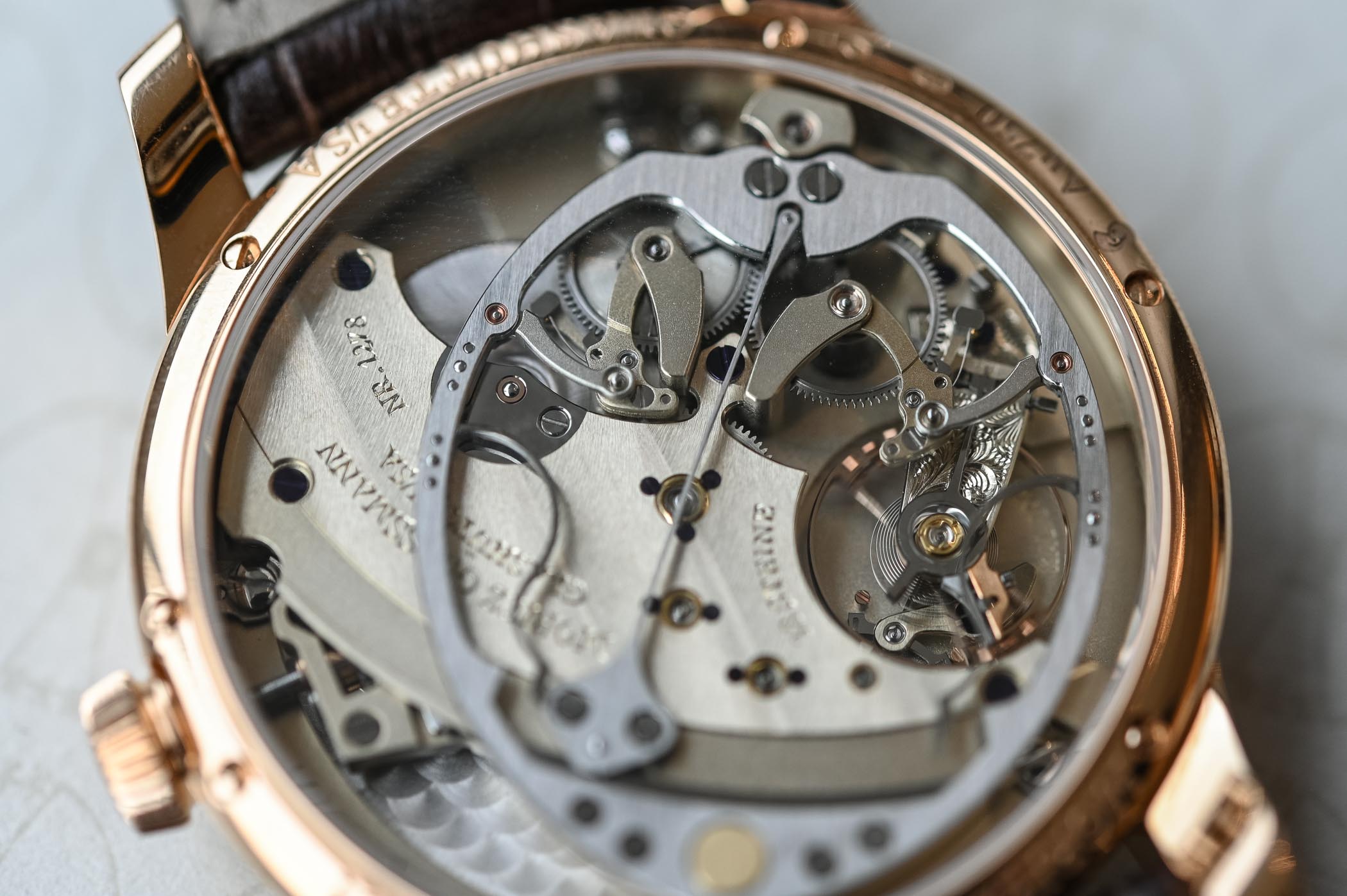
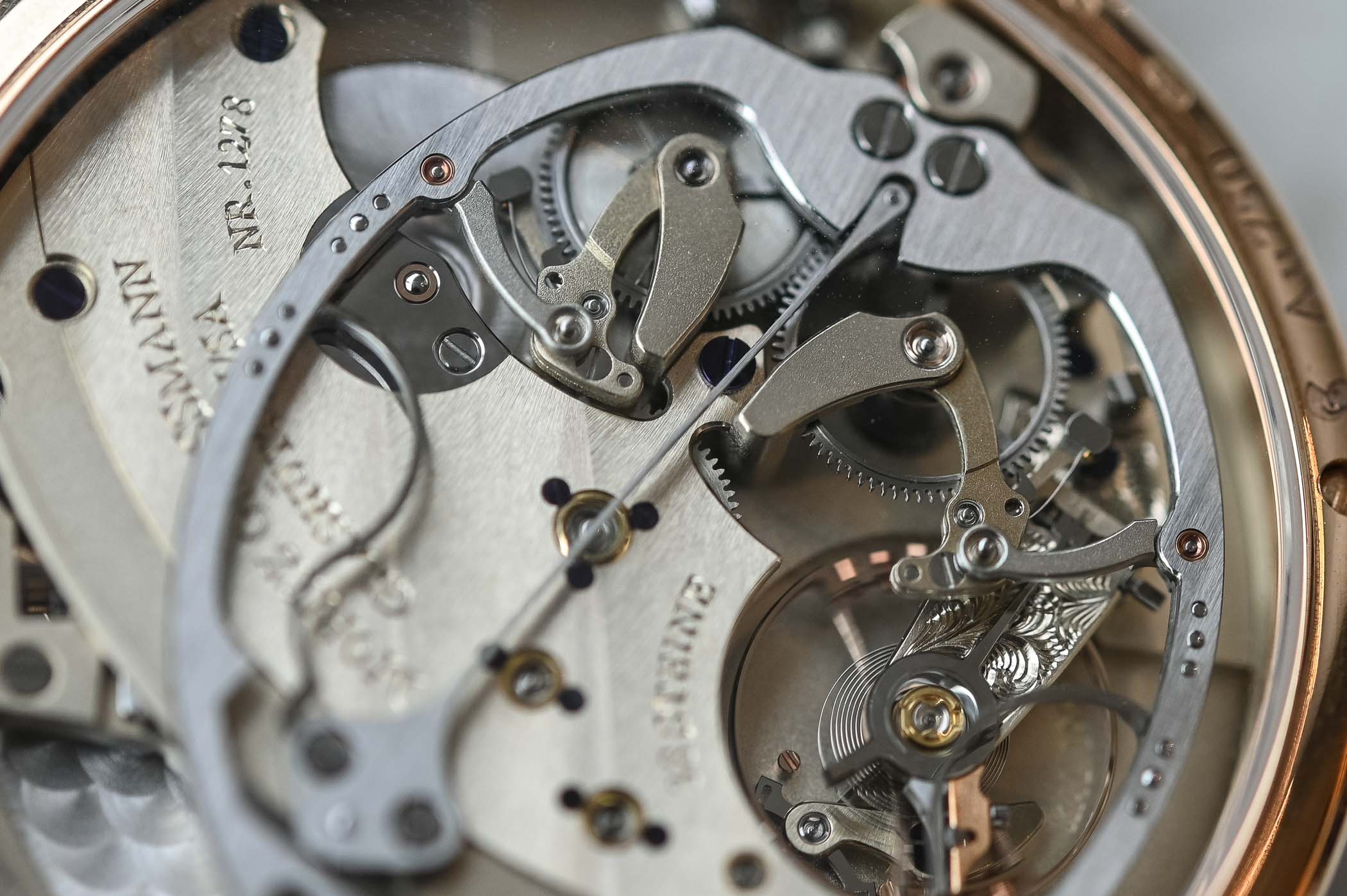
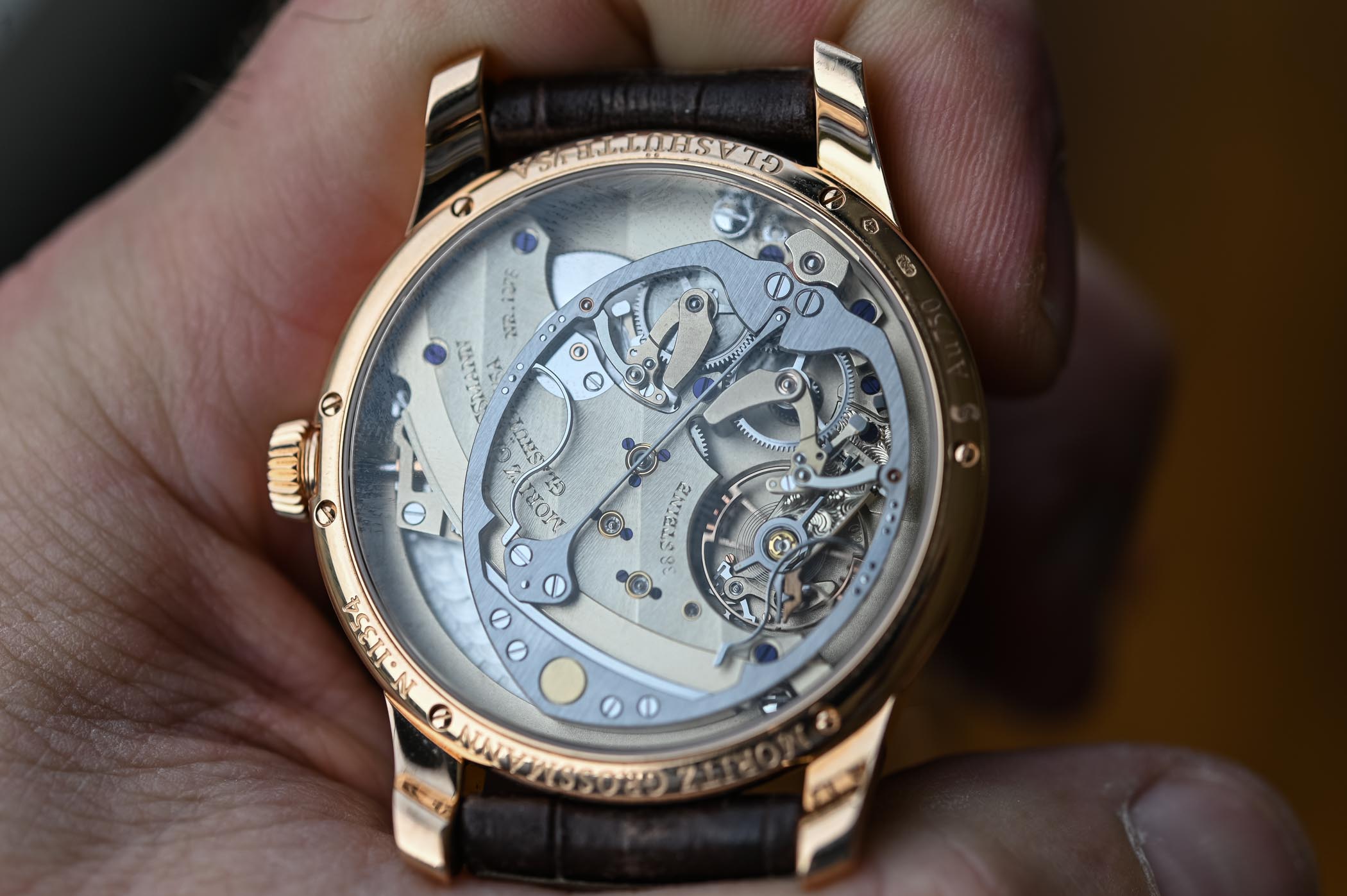
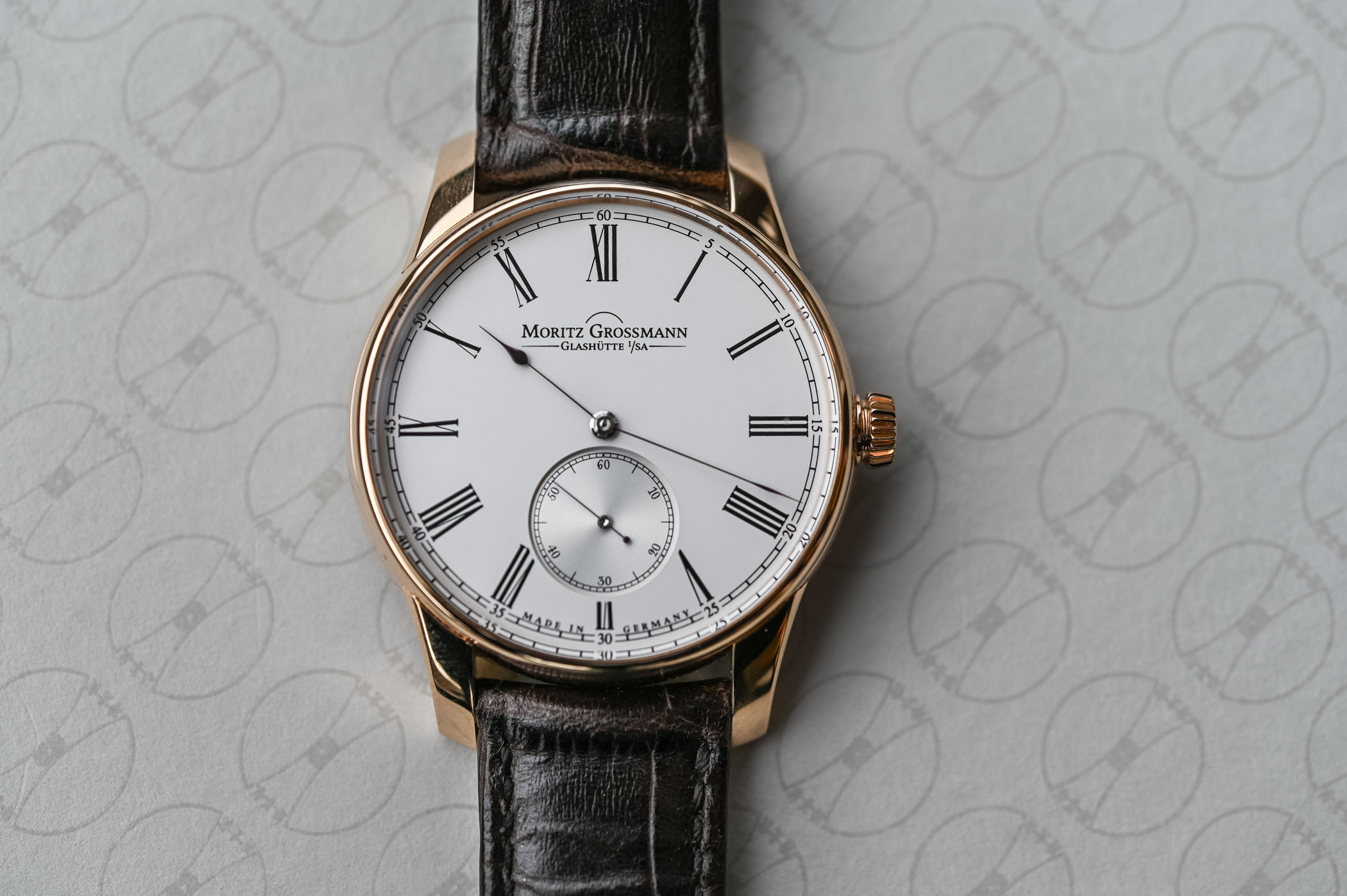
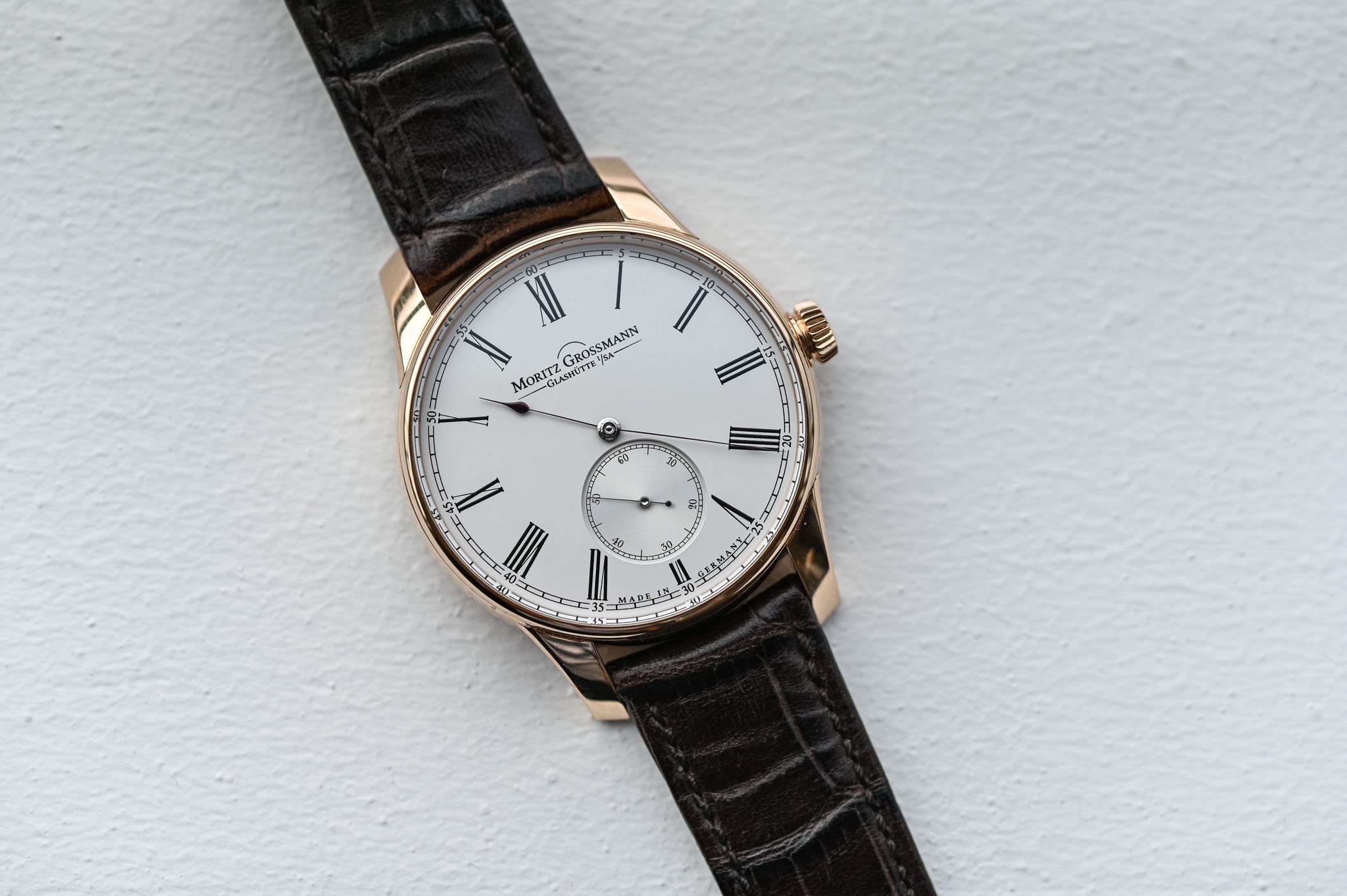
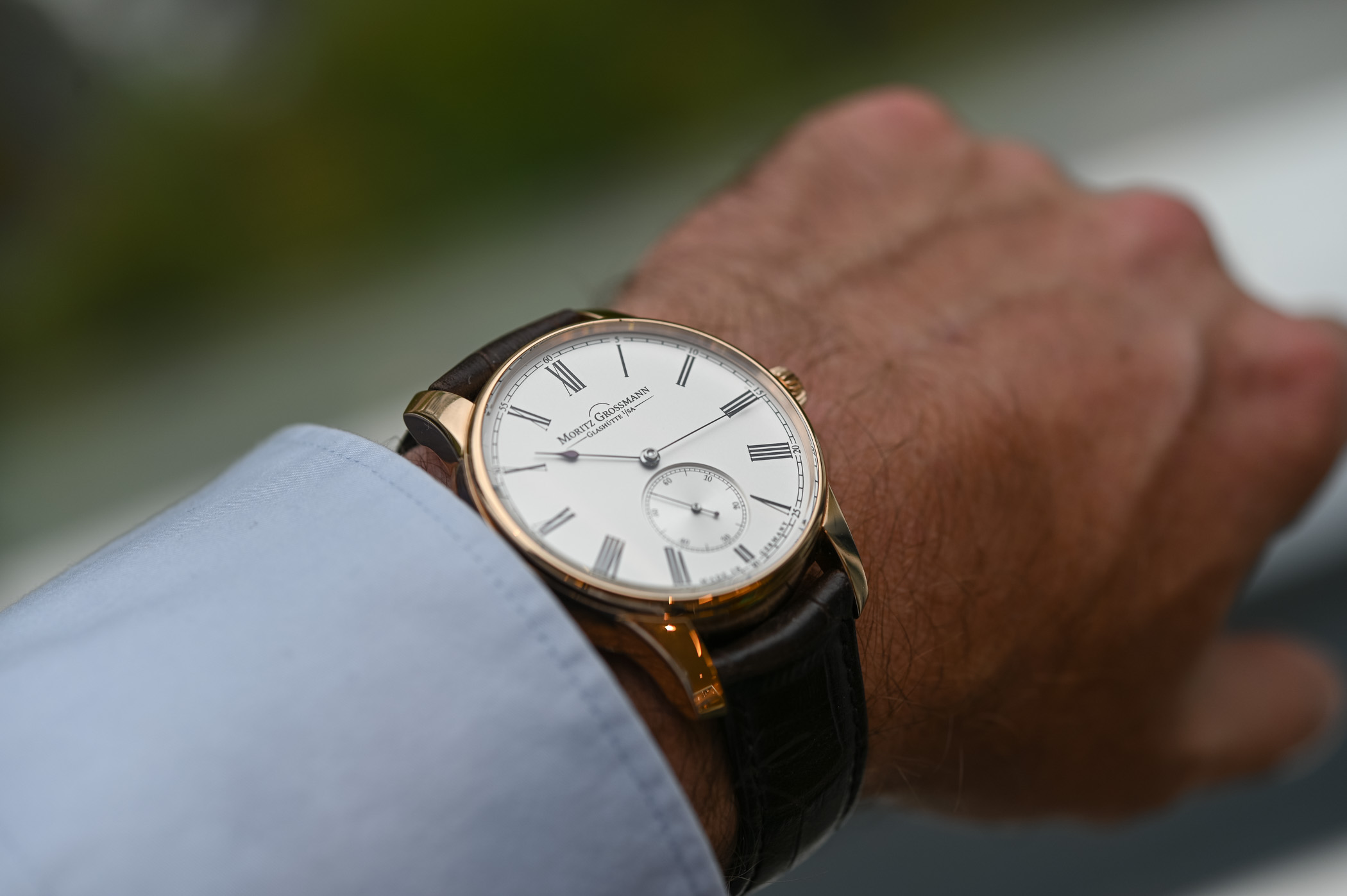
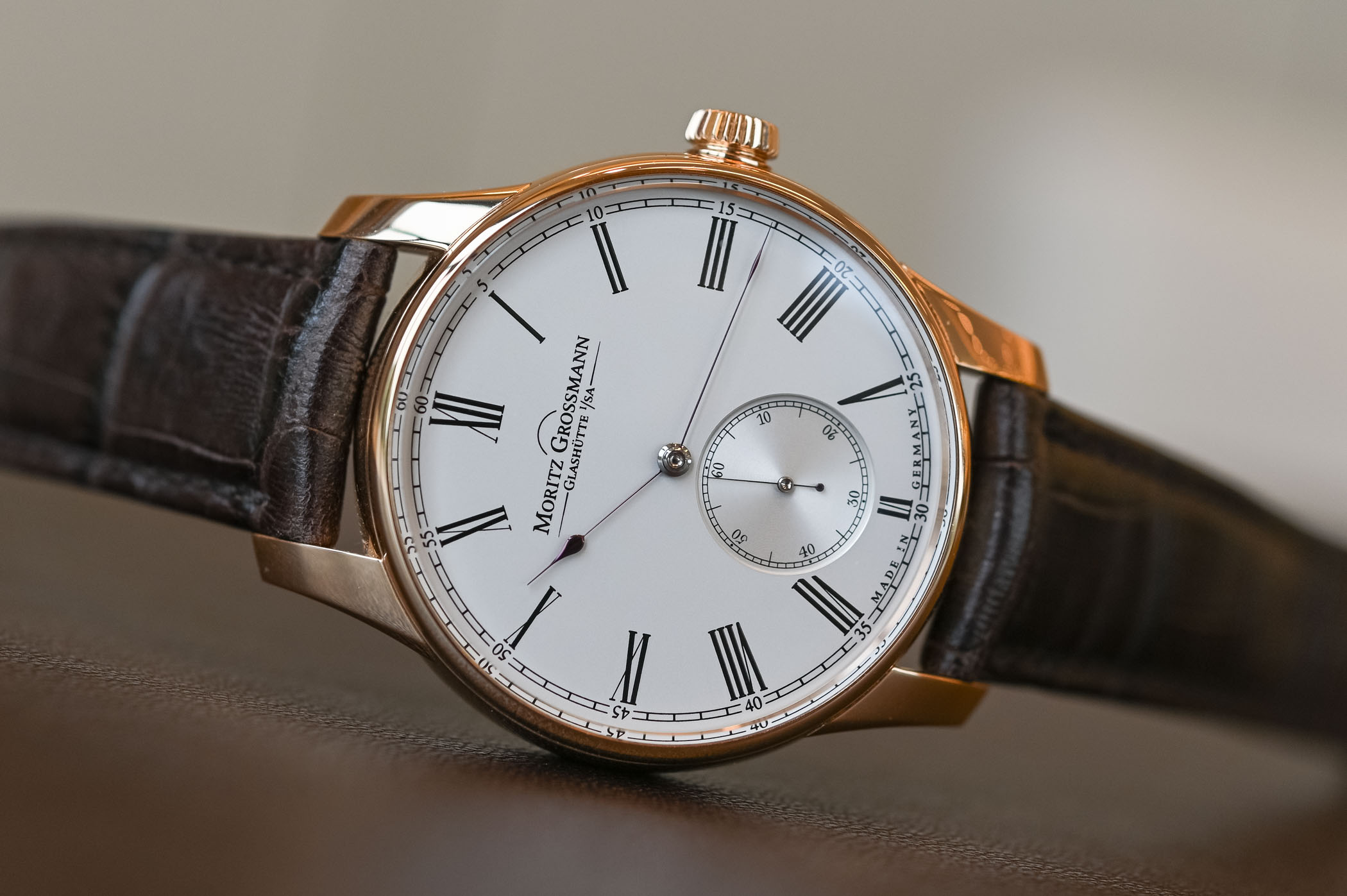
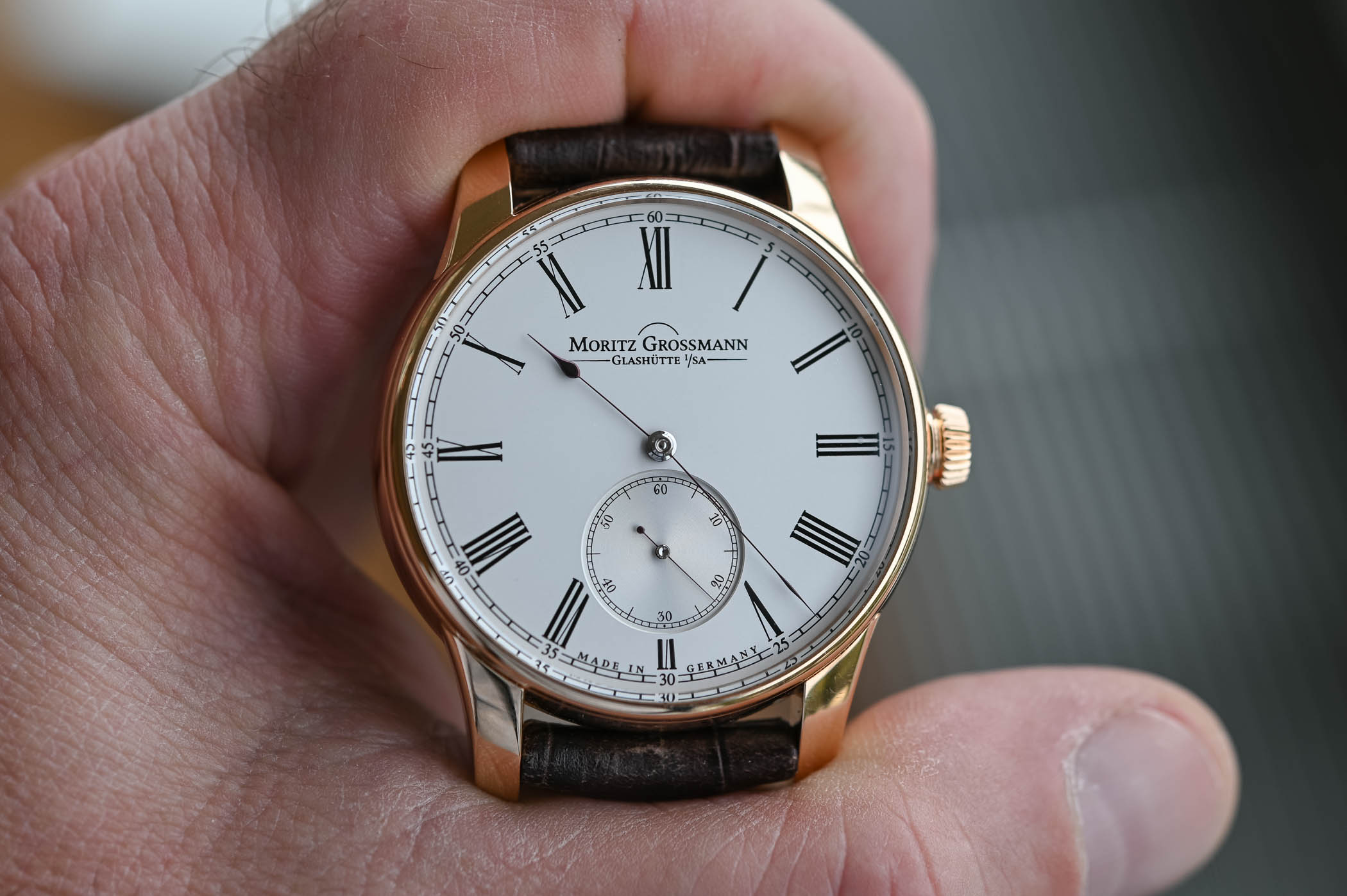
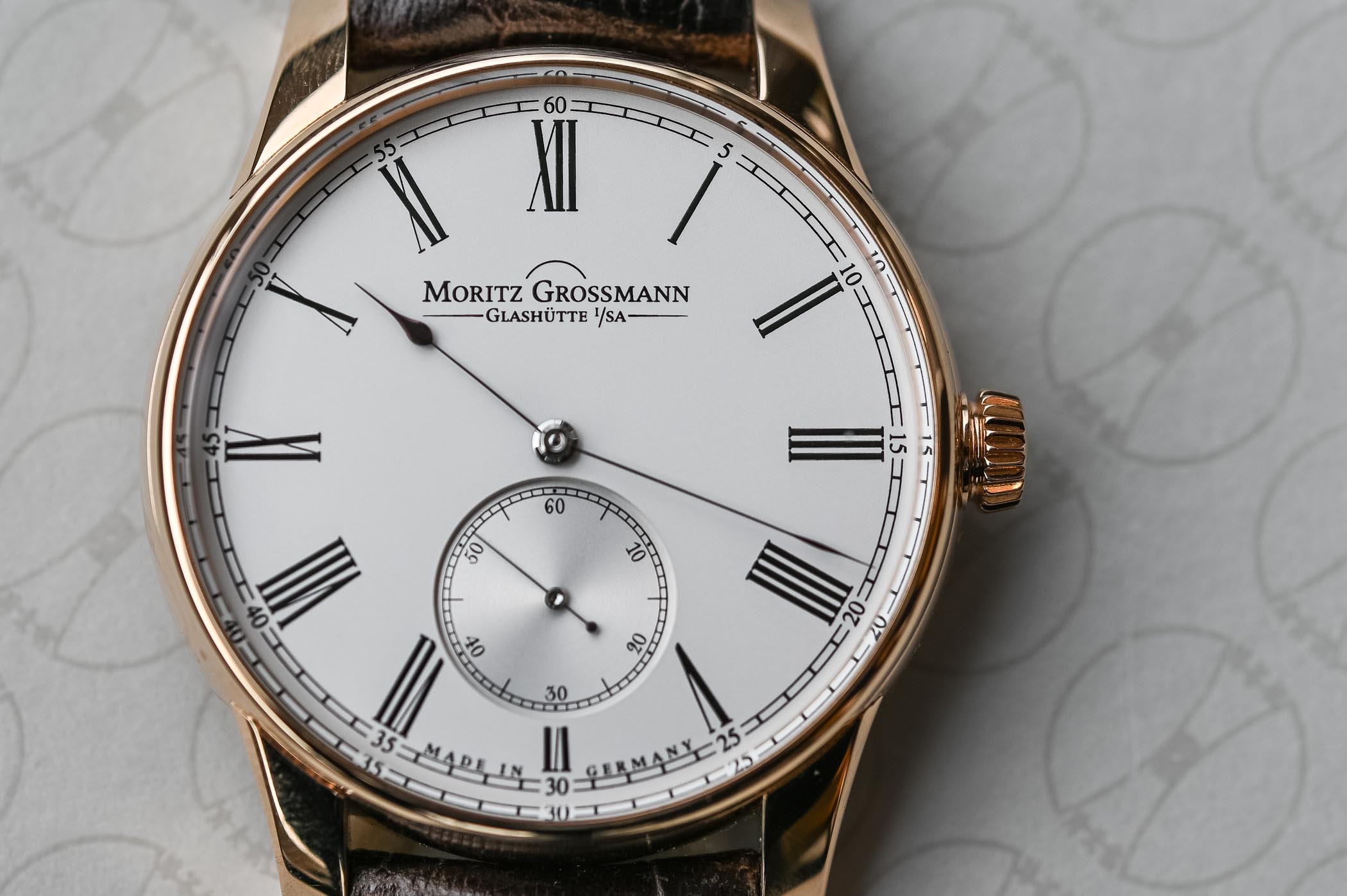
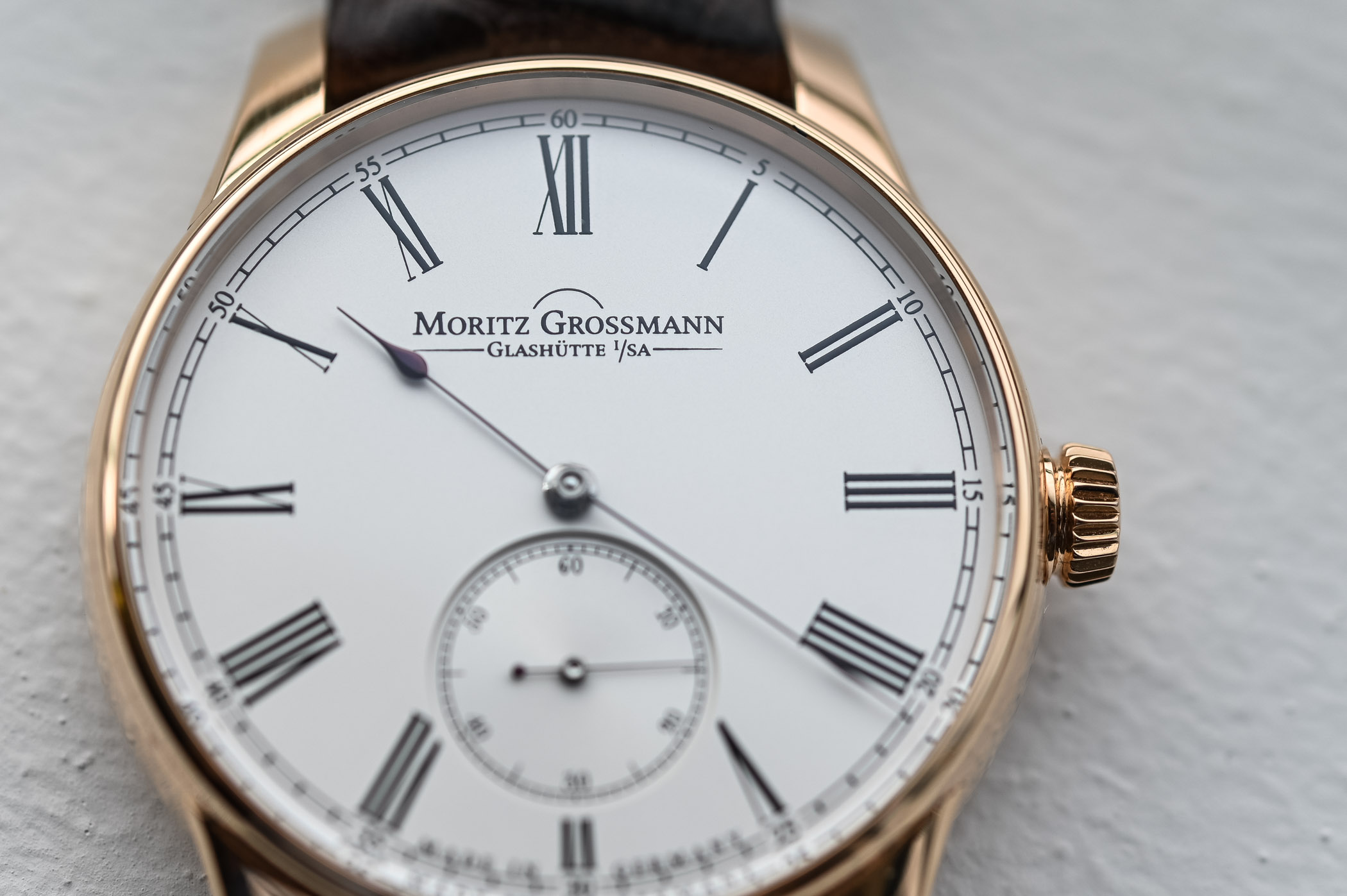
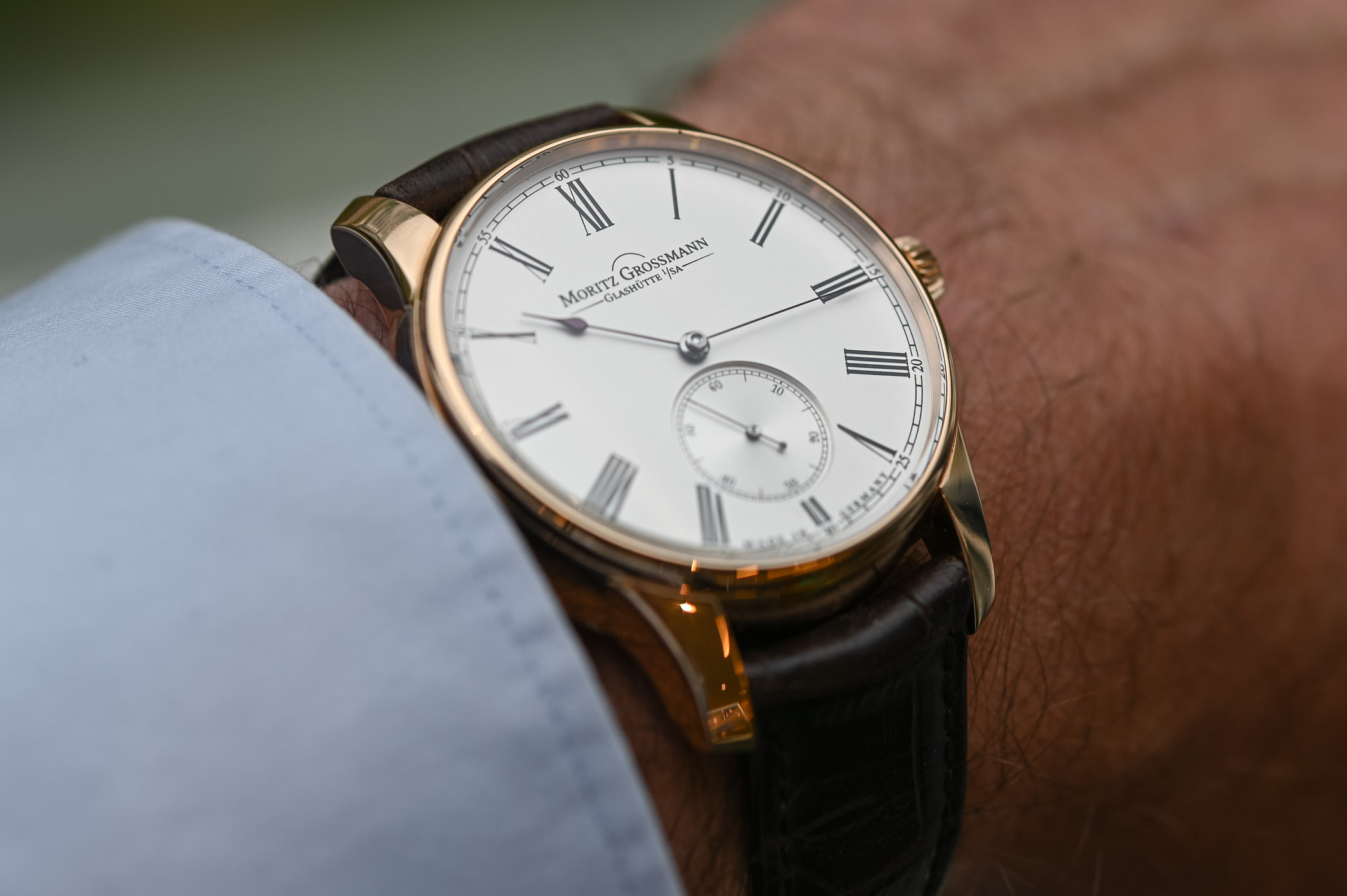



9 responses
Beautiful.
Aye, gorgeous. Reminds me of Ferrier’s Galet Classic.
thewatches.tv have a video on youtube showing the movement in action, if anyone’s interested.
Also love the way they are proud enough to describe that balance – I bet it holds its rate well. I suppose what with taking something once thought unwieldy and inefficient, and making it technically sound in a modern wristwatch, makes this somewhat analogous with Pratt’s and Voutilainen’s work on the Urban Jurgensen P8 detent escapement.
In the same way that a modern internal combustion engine is a reworking of Stevenson’s Reciprocating Engine, this takes an old idea and makes it relevant. It helps that it is very beautiful.
Though I much prefer manual-wound watches to automatics, this one is definitely an exception; and it’s probably my favorite German automatic watch so far.
Very beautiful and elegant.
Simply Amazing…
Fascinating piece of engineering. Beautifully built, an exceptionally desirable watch.
Taking time to perfect the prototype paid off big time. A very desirable watch. Simply put well done